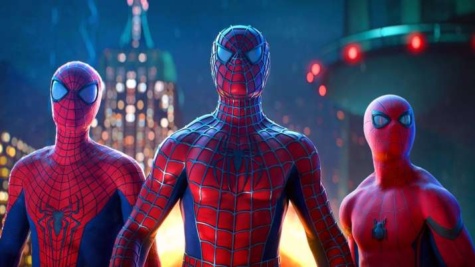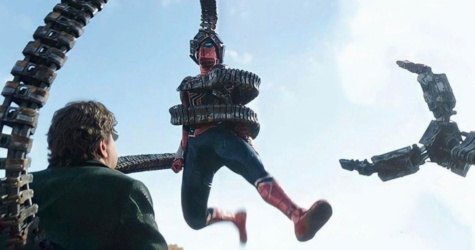
Reaghan Mulligan | Newsroom Manager
January 21, 2022
Spider-Man: No Way Home was released in theaters on December 17, 2021, immediately securing a high rank in the ‘new movie’ hierarchy. Its success marked a progression in theater releases and a return of movie-going since the start of COVID-19. The pandemic showed to be no match for fans of the Marvel Universe, causing No Way Home to break box office records when its debut accumulated a gross amount of $260 million from just over 4,000 theaters nationwide. Fans gathered from near and far to unite in admiration of the nostalgic story of Peter Parker, awaiting new conflicts and resolutions in the third installment of Tom Holland’s Spider-Man.
In 2019, Spider-Man: Far From Home introduced the audience to Mysterio, played by Jake Gyllenhaal, who plays a key role in manipulating the young vigilante and ultimately exposes his identity to the world. The romantic conclusion where Peter Parker finally got the girl—classmate MJ, played by Zendaya—set a hopeful tone for the third movie, which rapidly disintegrates just minutes into No Way Home. The third movie picks up mere days after the conclusion of Spider-Man’s European trials and tribulations, sending the audience on an intense goose chase filled with nostalgia, tragedy, and of course, the friendly neighborhood Spider-Man.
With his identity now revealed, the life of Peter Parker and Spider-Man quickly morph into one entity, making it much harder to separate Parker’s action-packed, crime-fighting extracurriculars from his teenage life. At the start of the movie, Parker is plagued by disappointment as news of his secret vigilante identity reaches the Admission Office of the Massachusetts Institute of Technology (MIT), Peter’s dream school, and causes the rejection of his application and the applications of his two closest friends. In an act of desperation, Parker seeks the help of Dr. Strange—Benedict Cumberpatch—with the rash idea of wiping the memories of the population, to once again conceal his identity as Spider-Man. Despite Strange’s doubt of the plan, the spell is attempted. Peter Parker’s life takes a turn for the worse as the faulted spell results in unsuspecting consequences that threaten Spider-Man for the rest of the film.

In an attempt to appeal the denials to MIT, Peter frantically chases an admissions officer to a bridge, where he is met with the first consequence of the spell’s miscalculation: Otto Octavius. The uninvited visitor’s presence is a blast of nostalgia from Spider-Man 2 (2004) where he first appears in Tobey Macguire’s Spider-Man. The incorporation of past foes from both Tobey Macguire and Andrew Garfield’s Spider-Man proves to be a vital aspect of the movie. Peter Parker is put up against obscure characters from the two other Spider-Men’s pasts, such as Max Dillon, Curt Conners, and the Green Goblin, who ultimately murders Parker’s Aunt May, taking a slightly different, yet predictable route aligning with the killing of both Spider-Men’s Uncle Ben.
Up until the release of the long-awaited movie, fans had speculated that the three Spider-Men would finally come together, despite the persistent denial of Andrew Garfield (The Amazing Spider-Man 1, The Amazing Spider-Man 2). To their approval, the different generations of Spider-Men unite via the same portals that displaced Octavius, Dillon, and the other men from the Spider-Man Multiverse, and must hone their individual skills to defeat the violent antagonists and return them to their rightful universe. A unification that incorporated both nostalgia and prolonged relief, the three form a unique connection as different variations of the same vigilante. Unlike before, the boys must work as a team and overcome their comfort with individuality for the greater good.
“I had a feeling that there would be crossovers since they referenced some in the trailers,” junior Amanda Cabagbag said. “All of them crossing over from different universes actually makes sense in the context of their comics and the multiverse, so I am glad they managed to tie it all together.”
Unfortunately, Peter Parker’s life did not return to normal after the elimination of this movie’s threats; instead, it flipped upside down. In a final attempt to reverse the effects of the wayward spell, Parker requests Dr. Strange one final time to reinstate the spell, causing a ripple effect of amnesia to hit the globe, even wiping the memory of his closest friends MJ and Ned of his very existence. The movie ends in painstaking melancholy as Peter Parker finds himself truly alone, without the comfort of MJ, Ned, or his late Aunt May.
“The overall movie was a cinematic masterpiece,” junior Jules Vilardo said. “I really enjoyed the relationship that was formed between the three Spider-Men and also enjoyed all the ‘easter egg’ jokes hidden throughout the movie.”
Lasting over two and a half hours, Spider-Man: No Way Home filled the length of the film to the brim with action, suspense, and valuable lessons. Its release left most fans pleased with the events that took place and received excellent reviews from viewers globally. With its next-level graphics and stunts, coupled with cinematic twists and somber losses, Spider-Man: No Way Home deserves the uproar of support. Fans now sit on the edge of their seats awaiting the next move from the Marvel Universe.

Leave a Reply